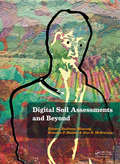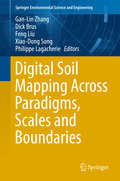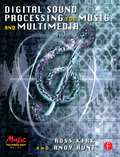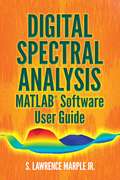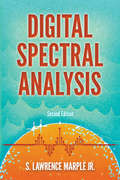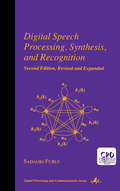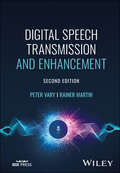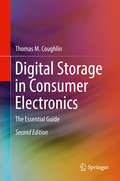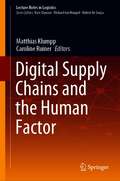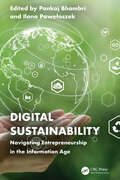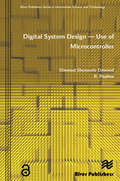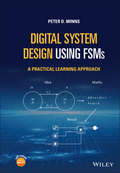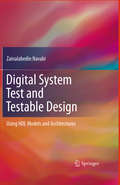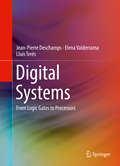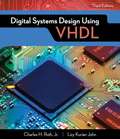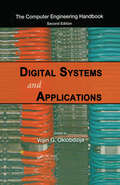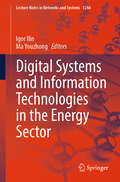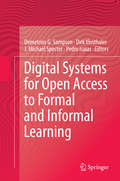- Table View
- List View
Digital Soil Assessments and Beyond: Proceedings of the 5th Global Workshop on Digital Soil Mapping 2012, Sydney, Australia
by Budiman Minasny Brendan P. Malone Alex B. McBratneyDigital soil assessments and beyond contains papers presented at the 5th Global Workshop on Digital Soil Mapping, held 10-13 April 2012 at the University of Sydney, Australia. The contributions demonstrate the latest developments in digital soil mapping as a discipline with a special focus on the use of map products to drive policy decisions partic
Digital Soil Mapping Across Paradigms, Scales and Boundaries
by Feng Liu Gan-Lin Zhang Dick Brus Xiao-Dong Song Philippe LagacherieThis book contains papers presented at the 6th Global Workshop on Digital SoilMapping, held 11-14 November 2014 at the Institute of Soil Science, ChineseAcademy of Sciences of Nanjing, China. Digital soil mapping is advancing ondifferent fronts at different paces throughout the world. The researches andapplications on DSM are moving from method development to realizations indifferent scales and regions, serving the generation of national andcontinental to global soil grids. Meanwhile, new ideas and insights on mapping complex soil-landscapes such as flat plains,anthropogenically altered agriculture and urban spaces are emerging, with the help of new paradigms and models. The goal of the sixth workshop was to review and discuss the state ofthe art in digital soil mapping, and to explore strategies for bridgingresearch, production, and environmental applications. Thisbook provides a very useful and comprehensive overview of the status of digitalsoil mapping, in which graduate students, scientists and specialists workingwithin the field of geography can find the spatial prediction approaches andrelated theory.
Digital Sound Processing for Music and Multimedia (Focal Press Music Technology Ser.)
by Andy Hunt Ross KirkProvides an introduction to the nature, synthesis and transformation of sound which forms the basis of digital sound processing for music and multimedia. Background information in computer techniques is included so that you can write computer algorithms to realise new processes central to your own musical and sound processing ideas. Finally, material is inlcuded to explain the way in which people contribute to the development of new kinds of performance and composition systems.Key features of the book include:· Contents structured into free-standing parts for easy navigation· `Flow lines' to suggest alternative paths through the book, depending on the primary interest of the reader.· Practical examples are contained on a supporting website. Digital Sound Processing can be used by anyone, whether from an audio engineering, musical or music technology perspective. Digital sound processing in its various spheres - music technology, studio systems and multimedia - are witnessing the dawning of a new age. The opportunities for involvement in the expansion and development of sound transformation, musical performance and composition are unprecedented.The supporting website (www.york.ac.uk/inst/mustech/dspmm.htm) contains working examples of computer techniques, music synthesis and sound processing.
Digital Sovereignty in Cyber Security: First International Workshop, CyberSec4Europe 2022, Venice, Italy, April 17–21, 2022, Revised Selected Papers (Communications in Computer and Information Science #1807)
by Antonio Skarmeta Antonio Lioy Daniele Canavese Sara MatheuThis book constitutes papers presented during the workshop session titled “CyberSec4Europe - Research to Innovation: Common Research Framework on Security and Privacy” during the Privacy Symposium hosted by Università Ca’ Foscari in Venice, Italy, in April 2022. The 11 peer-reviewed selected papers present findings, conclusions, research, and recommendations in various security-related areas, from highly technical ones (e.g., software and network security) to law and human-centric ones (e.g., governance and cybersecurity awareness).
Digital Spectral Analysis MATLAB® Software User Guide: Matlab Software User Guide (Dover Books on Electrical Engineering)
by S. Lawrence Marple, Jr.This user guide serves as a companion to Digital Spectral Analysis, Second Edition (Dover Publications, 2019), illustrating all the text's techniques and algorithms, plus time versus frequency analysis. The spectral demonstrations use MATLAB software that encompasses the full experience from inputting signal sources, interactively setting technique parameters and processing with those parameters, and choosing from a variety of plotting techniques to display the results. The processing functions and scripts have been coded to automatically handle sample data that is either real-valued or complex-valued, permitting the user to simply modify the demonstration scripts to input their own data for analysis. Four integrated software categories support the demonstrations. These are the main MATLAB spectral demonstration scripts, supporting MATLAB plotting scripts, MATLAB processing functions listed in this guide, and signal sample data sources. Scripts and demonstration data files can be found on the Dover website for free downloading; see the Introduction for details.
Digital Spectral Analysis: Second Edition (Dover Books on Electrical Engineering)
by S. Lawrence Marple, Jr.Digital Spectral Analysis offers a broad perspective of spectral estimation techniques and their implementation. Coverage includes spectral estimation of discrete-time or discrete-space sequences derived by sampling continuous-time or continuous-space signals. The treatment emphasizes the behavior of each spectral estimator for short data records and provides over 40 techniques described and available as implemented MATLAB functions. In addition to summarizing classical spectral estimation, this text provides theoretical background and review material in linear systems, Fourier transforms, matrix algebra, random processes, and statistics. Topics include Prony's method, parametric methods, the minimum variance method, eigenanalysis-based estimators, multichannel methods, and two-dimensional methods. Suitable for advanced undergraduates and graduate students of electrical engineering — and for scientific use in the signal processing application community outside of universities — the treatment's prerequisites include some knowledge of discrete-time linear system and transform theory, introductory probability and statistics, and linear algebra. 1987 edition.
Digital Speech Processing, Synthesis, and Recognition: Synthesis, and Recognition, Second Edition, (Signal Processing and Communications #7)
by Sadaoki FuruiA study of digital speech processing, synthesis and recognition. This second edition contains new sections on the international standardization of robust and flexible speech coding techniques, waveform unit concatenation-based speech synthesis, large vocabulary continuous-speech recognition based on statistical pattern recognition, and more.
Digital Speech Transmission and Enhancement: Enhancement, Coding And Error Concealment (IEEE Press)
by Rainer Martin Peter VaryDIGITAL SPEECH TRANSMISSION AND ENHANCEMENT Enables readers to understand the latest developments in speech enhancement/transmission due to advances in computational power and device miniaturization The Second Edition of Digital Speech Transmission and Enhancement has been updated throughout to provide all the necessary details on the latest advances in the theory and practice in speech signal processing and its applications, including many new research results, standards, algorithms, and developments which have recently appeared and are on their way into state-of-the-art applications. Besides mobile communications, which constituted the main application domain of the first edition, speech enhancement for hearing instruments and man-machine interfaces has gained significantly more prominence in the past decade, and as such receives greater focus in this updated and expanded second edition. Readers can expect to find information and novel methods on: Low-latency spectral analysis-synthesis, single-channel and dual-channel algorithms for noise reduction and dereverberation Multi-microphone processing methods, which are now widely used in applications such as mobile phones, hearing aids, and man-computer interfaces Algorithms for near-end listening enhancement, which provide a significantly increased speech intelligibility for users at the noisy receiving side of their mobile phone Fundamentals of speech signal processing, estimation and machine learning, speech coding, error concealment by soft decoding, and artificial bandwidth extension of speech signals Digital Speech Transmission and Enhancement is a single-source, comprehensive guide to the fundamental issues, algorithms, standards, and trends in speech signal processing and speech communication technology, and as such is an invaluable resource for engineers, researchers, academics, and graduate students in the areas of communications, electrical engineering, and information technology.
Digital State: The Story of Minnesota's Computing Industry
by Thomas J. MisaAccounts of the early events of the computing industry—the Turing machine, the massive Colossus, the ENIAC computer—are well-told tales, and equally well known is the later emergence of Silicon Valley and the rise of the personal computer. Yet there is an extraordinary untold middle history—with deep roots in Minnesota. From the end of World War II through the 1970s, Minnesota was home to the first computing-centered industrial district in the world.Drawing on rare archival documents, photographs, and a wealth of oral histories, Digital State unveils the remarkable story of computer development in the heartland after World War II. These decades found corporations—concentrated in large part in Minnesota—designing state-of-the-art mainframe technologies, revolutionizing new methods of magnetic data storage, and, for the first time, truly integrating software and hardware into valuable products for the American government and public. Minnesota-based companies such as Engineering Research Associates, Univac, Control Data, Cray Research, Honeywell, and IBM Rochester were major international players and together formed an unrivaled epicenter advancing digital technologies. These companies not only brought vibrant economic growth to Minnesota, they nurtured the state&’s present-day medical device and software industries and possibly even tomorrow&’s nanotechnology.Thomas J. Misa&’s groundbreaking history shows how Minnesota recognized and embraced the coming information age through its leading-edge companies, its workforce, and its prominent institutions. Digital State reveals the inner workings of the birth of the digital age in Minnesota and what we can learn from this era of sustained innovation.
Digital Storage in Consumer Electronics
by Thomas M. CoughlinCan you imagine life without your cell phone, laptop, digital camera, iPod, BlackBerry, flat-screen TV, or DVD player? The skyrocketing demand for devices that provide simple, immediate access to large amounts of content is driving required digital storage capacity to unprecedented levels. Designing digital storage into consumer electronics is crucial to the performance and cost of these devices. However, as our requirements for digital content storage grow, so does the formidable difficulty of implementing design solutions that are rugged, long-lasting, power-miserly, secure, network-accessible and can still fit in the palm of your hand! This book provides the background necessary to understand common digital storage devices and media. It helps readers decide which methods of storage work best for which kinds of devices, and then teaches designers how to successfully integrate them into consumer products. * Presents best practices for selecting, integrating, and using storage devices to achieve higher performance, greater reliability and lower cost * Teardown photos provide rare visuals of the "guts" of the devices discussed * Covers hot topics including flash memory, DVRs, Apple iPods, home networks, and automotive electronics, from basic layouts to standards, advanced features, and exciting growth opportunities
Digital Storytelling for Educative Purposes: Providing an Evidence-Base for Classroom Practice (Studies in Singapore Education: Research, Innovation & Practice #1)
by Phillip Alexander Towndrow Galyna KogutThis book is an exposition of a curriculum innovation within the complex yet fertile ground of school-based education in Singapore. Beyond straightforward descriptions and protocols, this book purposefully connects classroom practices with theories in a clear, uncomplicated way. The result provides a series of rationales for action, reflection and understanding that other publications in digital storytelling sometimes fail to cover or explain in sufficient detail. Broadly, these include digital multimodal authorship; teachers’ and students’ storytelling task design and assessment; the use of digital storytelling as a reflective and reflexive expression of teachers’ professionalism; and dialogism in classroom practice.
Digital Storytelling: A Beginner’s Guide
by Mary SturgillThis is a beginner’s guide on digital storytelling. You will learn what it takes to produce quality digital stories for use on any digital media platform, including but not limited to your own website, YouTube, social media, etc. These stories range from blogging to podcasting, from visual essays to short promo pieces, and from heartfelt human interest stories to hard news investigations and documentaries. This Primer is the place for you to start your journey.
Digital Storytelling: The Narrative Power of Visual Effects in Film (The\mit Press Ser.)
by Shilo T. McCleanHow digital visual effects in film can be used to support storytelling: a guide for scriptwriters and students.Computer-generated effects are often blamed for bad Hollywood movies. Yet when a critic complains that "technology swamps storytelling" (in a review of Van Helsing, calling it "an example of everything that is wrong with Hollywood computer-generated effects movies"), it says more about the weakness of the story than the strength of the technology. In Digital Storytelling, Shilo McClean shows how digital visual effects can be a tool of storytelling in film, adding narrative power as do sound, color, and "experimental" camera angles—other innovative film technologies that were once criticized for being distractions from the story. It is time, she says, to rethink the function of digital visual effects.Effects artists say—contrary to the critics—that effects always derive from story. Digital effects are a part of production, not post-production; they are becoming part of the story development process. Digital Storytelling is grounded in filmmaking, the scriptwriting process in particular. McClean considers crucial questions about digital visual effects—whether they undermine classical storytelling structure, if they always call attention to themselves, whether their use is limited to certain genres—and looks at contemporary films (including a chapter-long analysis of Steven Spielberg's use of computer-generated effects) and contemporary film theory to find the answers. McClean argues that to consider digital visual effects as simply contributing the "wow" factor underestimates them. They are, she writes, the legitimate inheritors of film storycraft.
Digital Supply Chains and the Human Factor (Lecture Notes in Logistics)
by Matthias Klumpp Caroline RuinerThis book covers topics such as digitalization of production, operations, logistics and supply chains leading to new requirements for human capabilities and collaboration. The content is relevant for research as well as industry as digitalization is shaping all value chain processes anew. A special focus is directed towards an interdisciplinary perspective, including management science, economics, sociology, work science, computer science and psychology. In order to foster the dialogue between business practice and academics as well as university teaching and research, this contributed book is addressing academic as well as professional business views on digitalization.
Digital Sustainability: Navigating Entrepreneurship in the Information Age
by Pankaj Bhambri and Ilona PawełoszekDigital Sustainability: Navigating Entrepreneurship in the Information Age explores the intersection of technology and sustainability, offering a panoramic view of innovative strategies and solutions for building a more environmentally conscious and socially responsible future. From exploring the transformative potential of blockchain technology in sustainable supply chains to harnessing the power of Artificial Intelligence (AI) and machine learning for environmental monitoring and conservation, each chapter presents cutting-edge insights and practical applications. The book highlights the ethical implications of entrepreneurship and data privacy, focusing on the potential of AI and machine learning for sustainable resource utilization and decision-making processes. Delving into areas such as renewable energy integration, data privacy, cybersecurity, IoT entrepreneurship, smart cities, and beyond, this book equips entrepreneurs, policymakers, and researchers with the knowledge and tools needed to drive meaningful change in the digital era. With a rich tapestry of case studies, future perspectives, and actionable insights, this book offers a roadmap for entrepreneurs, engineers, business professionals, and those interested in technology and sustainability, focusing on redefining business models, fostering innovation, and creating a more connected, sustainable world.
Digital System Design - Use of Microcontroller: Use Of Microcontroller (River Publishers Series In Signal, Image And Speech Processing Ser.)
by Shenouda Dawoud R. PeplowEmbedded systems are today, widely deployed in just about every piece of machinery from toasters to spacecraft. Embedded system designers face many challenges. They are asked to produce increasingly complex systems using the latest technologies, but these technologies are changing faster than ever. They are asked to produce better quality designs with a shorter time-to-market. They are asked to implement increasingly complex functionality but more importantly to satisfy numerous other constraints. To achieve the current goals of design, the designer must be aware with such design constraints and more importantly, the factors that have a direct effect on them.One of the challenges facing embedded system designers is the selection of the optimum processor for the application in hand; single-purpose, general-purpose or application specific. Microcontrollers are one member of the family of the application specific processors.The book concentrates on the use of microcontroller as the embedded system?s processor, and how to use it in many embedded system applications. The book covers both the hardware and software aspects needed to design using microcontroller.The book is ideal for undergraduate students and also the engineers that are working in the field of digital system design.Contents• Preface;• Process design metrics;• A systems approach to digital system design;• Introduction to microcontrollers and microprocessors;• Instructions and Instruction sets;• Machine language and assembly language;• System memory; Timers, counters and watchdog timer;• Interfacing to local devices / peripherals;• Analogue data and the analogue I/O subsystem;• Multiprocessor communications;• Serial Communications and Network-based interfaces.
Digital System Design using FSMs: A Practical Learning Approach
by Peter D. MinnsThis is a complete update of the author's earlier book, FSM-Based Digital Design using Verilog HDL (Wiley 2008). Whilst the essential foundation content remains, the book has been considerably refreshed to cover the design of Finite State Machines (FSM) in place of Microprocessors, using a novel form of State Machines based on Toggle Flip Flops (TFF) and Data Flip Flops (DFF). It follows a Linear Programmed Learning approach, enabling the reader to learn at their own pace, and to design their own FSM based systems.
Digital System Test and Testable Design
by Zainalabedin NavabiThis book is about digital system testing and testable design. The concepts of testing and testability are treated together with digital design practices and methodologies. The book uses Verilog models and testbenches for implementing and explaining fault simulation and test generation algorithms. Extensive use of Verilog and Verilog PLI for test applications is what distinguishes this book from other test and testability books. Verilog eliminates ambiguities in test algorithms and BIST and DFT hardware architectures, and it clearly describes the architecture of the testability hardware and its test sessions. Describing many of the on-chip decompression algorithms in Verilog helps to evaluate these algorithms in terms of hardware overhead and timing, and thus feasibility of using them for System-on-Chip designs. Extensive use of testbenches and testbench development techniques is another unique feature of this book. Using PLI in developing testbenches and virtual testers provides a powerful programming tool, interfaced with hardware described in Verilog. This mixed hardware/software environment facilitates description of complex test programs and test strategies.
Digital Systems
by Jean-Pierre Deschamps Elena Valderrama Lluís TerésThis textbook for a one-semester course in Digital Systems Design describes the basic methods used to develop "traditional" Digital Systems, based on the use of logic gates and flip flops, as well as more advanced techniques that enable the design of very large circuits, based on Hardware Description Languages and Synthesis tools. It was originally designed to accompany a MOOC (Massive Open Online Course) created at the Autonomous University of Barcelona (UAB), currently available on the Coursera platform. Readers will learn what a digital system is and how it can be developed, preparing them for steps toward other technical disciplines, such as Computer Architecture, Robotics, Bionics, Avionics and others. In particular, students will learn to design digital systems of medium complexity, describe digital systems using high level hardware description languages, and understand the operation of computers at their most basic level. All concepts introduced are reinforced by plentiful illustrations, examples, exercises, and applications. For example, as an applied example of the design techniques presented, the authors demonstrate the synthesis of a simple processor, leaving the student in a position to enter the world of Computer Architecture and Embedded Systems.
Digital Systems Design Using VHDL (Activate Learning With These New Titles From Engineering! Ser.)
by Charles Roth Lizy JohnLearn how to effectively use the industry-standard hardware description language, VHDL, as DIGITAL SYSTEMS DESIGN USING VHDL, 3E integrates VHDL into the digital design process. The book begins with a valuable review of basic logic design concepts before introducing the fundamentals of VHDL. The book concludes with detailed coverage of advanced VHDL topics.
Digital Systems Engineering
by William J. Dally John W. PoultonWhat makes some computers slow? What makes some digital systems operate reliably for years while others fail mysteriously every few hours? Why do some systems dissipate kilowatts while others operate off batteries? These questions of speed, reliability, and power are all determined by the system-level electrical design of a digital system. Digital Systems Engineering presents a comprehensive treatment of these topics. It combines a rigorous development of the fundamental principles in each area with down-to-earth examples of circuits and methods that work in practice. The book not only can serve as an undergraduate textbook, filling the gap between circuit design and logic design, but also can help practicing digital designers keep up with the speed and power of modern integrated circuits. The techniques described in this book, which were once used only in supercomputers, are now essential to the correct and efficient operation of any type of digital system.
Digital Systems and Applications (Computer Engineering Series)
by Vojin G. OklobdzijaNew design architectures in computer systems have surpassed industry expectations. Limits, which were once thought of as fundamental, have now been broken. Digital Systems and Applications details these innovations in systems design as well as cutting-edge applications that are emerging to take advantage of the fields increasingly sophisticated capabilities. This book features new chapters on parallelizing iterative heuristics, stream and wireless processors, and lightweight embedded systems. This fundamental text— Provides a clear focus on computer systems, architecture, and applications Takes a top-level view of system organization before moving on to architectural and organizational concepts such as superscalar and vector processor, VLIW architecture, as well as new trends in multithreading and multiprocessing. includes an entire section dedicated to embedded systems and their applications Discusses topics such as digital signal processing applications, circuit implementation aspects, parallel I/O algorithms, and operating systems Concludes with a look at new and future directions in computing Features articles that describe diverse aspects of computer usage and potentials for use Details implementation and performance-enhancing techniques such as branch prediction, register renaming, and virtual memory Includes a section on new directions in computing and their penetration into many new fields and aspects of our daily lives
Digital Systems and Information Technologies in the Energy Sector (Lecture Notes in Networks and Systems #1244)
by Igor Ilin Ma YouzhongDigital transformation and energy transition are undoubtedly the key trends of the last decade that are fundamentally changing the way countries, regions and the global community conduct their economic activities. At first glance, these are phenomena of completely different nature. The editors and authors of the book offer a closer look at the specifics of the development of each trend, the nature of their interdependence, analyze the possibilities of coexistence, and determine the potential effects of such technological symbiosis. The book is characterized by an original, interdisciplinary statement of the problem: description of various aspects of effective interaction between elements of energy and information-technology/digital infrastructures that jointly ensure information needs and compliance with energy efficiency requirements of the modern economy. At the same time, attention is paid to each technological trend separately, as well as to the possibilities of interaction between technological capabilities of energy and digital. International author teams of professionals in different fields offer an interesting perspective on certain aspects of modern technological development of various industries. The book will be of interest to both experienced researchers, undergraduate and graduate students, and practitioners, both energy and IT specialists and even mathematicians.
Digital Systems for Open Access to Formal and Informal Learning
by Dirk Ifenthaler J. Michael Spector Pedro Isaias Demetrios G. SampsonToday, Digital Systems and Services for Technology Supported Learning and Education are recognized as the key drivers to transform the way that individuals, groups and organizations "learn" and the way to "assess learning" in 21st Century. These transformations influence: Objectives - moving from acquiring new "knowledge" to developing new and relevant "competences"; Methods - moving from "classroom" based teaching to "context-aware" personalized learning; and Assessment - moving from "life-long" degrees and certifications to "on-demand" and "in-context" accreditation of qualifications Within this context, promoting Open Access to Formal and Informal Learning, is currently a key issue in the public discourse and the global dialogue on Education, including Massive Open Online Courses (MOOCs) and Flipped School Classrooms. This volume on Digital Systems for Open Access to Formal and Informal Learning contributes to the international dialogue between researchers, technologists, practitioners and policy makers in Technology Supported Education and Learning It addresses emerging issues related with both theory and practice, as well as, methods and technologies that can support Open Access to Formal and Informal Learning In the twenty chapters contributed by international experts who are actively shaping the future of Educational Technology around the world, topics such as: - The evolution of University Open Courses in Transforming Learning - Supporting Open Access to Teaching and Learning of People with Disabilities - Assessing Student Learning in Online Courses - Digital Game-based Learning for School Education - Open Access to Virtual and Remote Labs for STEM Education - Teachers' and Schools' ICT Competence Profiling - Web-Based Education and Innovative Leadership in a K-12 International School Setting are presented. An in-depth blueprint of the promise, potential, and imminent future of the field, Digital Systems for Open Access to Formal and Informal Learning is necessary reading for researchers and practitioners, as well as, undergraduate and postgraduate students, in educational technology.
Digital T Level: Digital Support Services and Digital Business Services (Core)
by Sonia Stuart Maureen EverettTackle the core elements of the Digital Support Services or Digital Business Services T Level with this comprehensive resource.Written by highly respected authors, Mo Everett and Sonia Stuart, this clear, accessible and thorough textbook will guide learners through the key principles, concepts and terminology, as well as providing the inside track into what it takes to kick-start a career in the Digital world.- Simplify complex topics with summary tables, diagrams, key term definitions and a glossary.- Track and strengthen knowledge by using learning outcomes at the beginning of every unit and 'Test Yourself' questions.- Apply knowledge and understanding across 100s of engaging activities and research tasks.- Prepare for exams and the employer-set project using practice questions and project practice exercises.- Get ready for the workplace with industry tips and real-world examples.- Be guided through the course by expert authors Mo Everett and Sonia Stuart, who draw on their extensive industry and teaching experience.The Digital Support Services and Digital Business Services route core elements are covered in this Student Textbook. We have released the Digital Support Services pathway core elements online, for free. Visit www.hoddereducation.co.uk/digitalsupportservices/pathwaycore to learn more.
